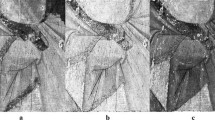Abstract
Curing compounds are widely used to cure concrete pavement because of their high efficiency and simple usability. Image processing has been proposed to facilitate quality control during construction by including a white-colored pigment in the sprayed compound. However, errors can occur as a result of a number of variables such as camera aperture, shutter speed, and illuminance during the picture-taking process. This paper proposes a method in which the “mastercurve” concept is applied to standardize the camera aperture and shutter speed. The shift function, y = 0.0067x2 − 0.2305x + 1.4171, is applied between the aperture and shutter speed, and a brightness value enabled to classify curing compounds under the same illuminance condition. In addition, the correlation between the illuminance and brightness of the images are identified via regression analysis. The results of analysis of sample images under various conditions indicate that the relative application rate of the curing compound can be evaluated. These results demonstrate that the proposed image processing methodology is suitable for curing compound quality control.
Similar content being viewed by others
References
ACI 308R-01 (2008). Guide to Curing Concrete.
Choi, S. and Won, M. C. (2008). Identification of compliance testing method for curing effectiveness, FHWA/TX-09/0-5106-2, CTR Technical Report, Texas Department of Transportation.
Huo, X. S. and Wong, L. U. (2006). “Experimental study of early-age behavior of high performance concrete deck slabs under different curing methods.” Constr. Build. Mater., Vol. 20, Issue 10, pp. 1049–1056, DOI: 10.1016/j.conbuildmat.2005.04.001.
McAndrew, A. (2004). “An introduction to digital image processing with MATLAB notes for SCM2511 image processing.” Sch. Comput. Sci. Math. Vic. Univ. Technol., pp. 1–264.
Papagiannakis, A. T. and Masad, E. A. (2008). Pavement Design and Materials, John Wiley & Sons.
Poole, T. S. (2006). Guide for curing of portland cement concrete pavements, Volume II,FHWA-HRT-05-038, USAE Research and Development Center, Federal Highway Administration.
Sun, P. (2013). A new protocol for evaluating concrete curing effectiveness, PhD Thesis, Texas A&M University.
Wang, K., Cable, J., and Ge, Z. (2006). “Evaluation of pavement curing effectiveness and curing effects on concrete properties.” J. Mater. Civ. Eng. Vol. 18, Issue 3, pp. 377–389, DOI: 10.1061/(ASCE)0899-1561(2006)18:3(377).
Young-Min, J. (2013). “Using the image processing for evaluation method of curing compound in highway construction.” Master’s Thesis of Chung-Ang University.
Yun, T., Underwood, B. S., and Kim, Y. R. (2009). “Time-temperature superposition for HMA with growing damage and permanent strain in confined tension and compression.” J. Mater. Civ. Eng., Vol. 22, Issue 5, pp. 415–422.
Author information
Authors and Affiliations
Corresponding author
Rights and permissions
About this article
Cite this article
Jung, Y., Lee, J.H., Mun, N.S. et al. Mastercurve-based image analysis method for curing compound quality control. KSCE J Civ Eng 21, 253–257 (2017). https://doi.org/10.1007/s12205-016-0277-z
Received:
Revised:
Accepted:
Published:
Issue Date:
DOI: https://doi.org/10.1007/s12205-016-0277-z




